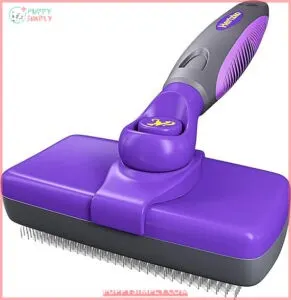This site is supported by our readers. We may earn a commission, at no cost to you, if you purchase through links.

Their shedding follows natural growth cycles throughout the year, with noticeable increases during spring and fall when they’re renewing their coats. Understanding what’s normal—and what might signal a problem—helps you manage the fur situation more effectively.
The right combination of grooming techniques, nutrition, and tools can dramatically reduce the amount of hair floating around your home while keeping your Cocker’s coat healthy and gorgeous.
Table Of Contents
- Key Takeaways
- Do Cocker Spaniels Shed?
- Cocker Spaniel Coat Types Explained
- Factors Influencing Shedding in Cocker Spaniels
- Managing and Reducing Shedding
- Grooming Needs for Cocker Spaniels
- Top 5 Grooming Products for Shedding Control
- Frequently Asked Questions (FAQs)
- Why does an English Cocker Spaniel shed so much?
- Are Cocker Spaniels hypoallergenic or low shedding dogs?
- What size crate do I need for a cocker spaniel?
- Are Cocker Spaniels hypoallergenic dogs?
- Are Cocker Spaniels suitable for allergy sufferers?
- Can spaying or neutering affect shedding patterns?
- Do puppies shed differently than adult dogs?
- What causes excessive shedding outside seasonal changes?
- How long does a shedding cycle last?
- Conclusion
Key Takeaways
- Cocker Spaniels shed moderately year-round (rating 3-4 out of 10), with dramatic seasonal increases in spring and fall when they blow out their undercoat, producing two to three times more loose fur during these 3-8 week cycles.
- Regular brushing at least three times weekly, combined with bathing every 4-6 weeks and a diet rich in omega-3 fatty acids and quality protein, can reduce household shedding by up to 40% while preventing mats and keeping the coat healthy.
- Health issues like hypothyroidism, Cushing’s disease, skin infections, and nutritional deficiencies can trigger excessive shedding beyond normal patterns, making veterinary evaluation essential when hair loss seems abnormal or patchy.
- Despite common misconceptions, Cocker Spaniels aren’t hypoallergenic—they produce significant dander and allergens that trigger allergies, making them generally unsuitable for allergy sufferers without strict management strategies like daily grooming and air filtration.
Do Cocker Spaniels Shed?
Yes, Cocker Spaniels do shed, though they’re considered moderate shedders compared to many other breeds. The amount of fur you’ll find around your home depends on several factors, from the time of year to your dog’s individual coat type.
Let’s break down what you can expect regarding shedding levels, seasonal patterns, and separating fact from fiction.
Shedding Level and Frequency
Generally, your Cocker Spaniel will shed at a moderate level, rating around 3 to 4 out of 10 in shedding intensity. This shedding happens year-round as part of their natural hair growth and coat renewal cycle.
You’ll notice individual variation among dogs, with some shedding more than others due to genetics and health. Understanding these shedding patterns helps you prepare for managing loose fur effectively.
Seasonal Shedding Patterns
Your Cocker Spaniel’s shedding intensifies dramatically twice each year—spring and fall—when they “blow out” their undercoat. These seasonal changes, triggered by shifts in daylight rather than temperature, generally last 3–8 weeks per cycle.
During these periods, you’ll notice two to three times more loose fur around your home, accounting for up to 70% of their annual coat renewal. Regular grooming is essential to manage shedding effectively.
Shedding Myths and Facts
Many people mistakenly believe Cocker Spaniels are hypoallergenic or barely shed, but veterinary consensus confirms they’re moderate shedders—rating around 3 to 4 on a 10-point scale. No breed is truly hypoallergenic; dog dander, not just fur, triggers allergies.
Genetic influence plays a major role in shedding intensity, and those dramatic coat blowouts you’re experiencing? They’re completely normal for this breed. Cocker Spaniels have a distinct double coat, which contributes to their shedding habits.
Cocker Spaniel Coat Types Explained
Not all Cocker Spaniel coats are created equal. Understanding your dog’s specific coat type helps you predict shedding patterns and plan the right grooming routine.
Let’s break down the key differences you’ll want to know about.
Double Coat Structure
Your Cocker Spaniel’s coat works like a two-layer insulation system, and understanding this structure helps you manage shedding effectively. The double coat includes a dense, woolly undercoat that traps air for temperature control, plus longer guard hairs on top that repel water and dirt.
Your Cocker Spaniel’s double coat—dense undercoat for warmth, protective guard hairs on top—is a two-layer insulation system that drives their shedding patterns
Here’s what makes this coat unique:
- Undercoat function: Fine fibers create warmth through trapped air, shedding heavily during seasonal blow periods in spring and fall.
- Guard hairs: Stronger topcoat strands stay stable year-round, protecting your dog from moisture and debris.
- Coat density: Higher hair follicle counts mean fuller coats but also greater matting potential without regular brushing.
- Genetic factors: The ancestral “A” allele on CFA28 determines double coat presence in most Cocker Spaniels.
- Growth patterns: Hair grows about 0.065 mm daily, with undercoat fibers nearly twice as numerous as topcoat hairs.
The undercoat sheds more dramatically when seasons change because hormonal shifts triggered by temperature and daylight tell your dog’s body to regenerate its insulating layer. That’s why you’ll notice more fur around your home during spring and autumn—it’s not excessive shedding, just nature’s way of preparing your Cocker Spaniel for the next season.
English Vs. American Cocker Spaniel Coats
When you’re choosing between these two Cocker Spaniel coat types, you’ll notice significant differences that directly affect your daily maintenance routine. The American variety sports a fuller, more profuse coat that sometimes reaches the floor, while the English type carries a flatter, silkier coat with moderate feathering.
| Feature | English Cocker Spaniels | American Cocker Spaniels |
|---|---|---|
| Coat Length | Moderate (16″ height) | Longer, more flowing |
| Feathering Abundance | Moderate on legs/ears | Profuse on legs/chest/abdomen/ears |
| Shedding Amount | Moderate level | Higher due to denser coat |
| Color Variations | 60% blue roan dominant | Wide variety of solid/parti-colors |
Grooming English Cocker Spaniels requires less effort compared to grooming American Cocker Spaniels, whose abundant feathering demands more frequent brushing to prevent tangles. Your grooming needs will vary based on which type you own.
Coat Color and Shedding
Although you might’ve heard that certain coat colors shed more than others, scientific evidence doesn’t support a direct genetic link between Cocker Spaniel coat color and shedding amount.
Anecdotal reports from breeders occasionally mention darker coats shedding more, but it’s really about visibility—dark hair shows up clearly on light furniture.
Regular grooming impacts shedding control equally across all color variations.
Factors Influencing Shedding in Cocker Spaniels
Not all Cocker Spaniels shed the same amount, and understanding why can help you manage your dog’s coat more effectively. Several key factors determine how much fur you’ll find around your home, from your dog’s genetic makeup to their overall health.
Let’s look at the main influences that affect shedding in these beautiful dogs.
Genetics and Breed Lines
Your Cocker Spaniel’s shedding isn’t random—it’s written in their genes. Shedding heritability means coat genetics play a major role, and breed variation between American Cocker Spaniels and English Cocker Spaniels matters. Selective breeding has shaped Cocker Spaniel breeds differently:
- MC5R gene variants control shedding intensity
- American vs English Cocker Spaniel coat differences affect grooming needs
- Show lines shed more than field lines
- Genetic testing helps breeders select low-shedding dogs
- Cocker Spaniel breed characteristics vary by lineage
Health Conditions Affecting Shedding
Your dog’s shedding can signal underlying health problems. Hormonal imbalances like hypothyroidism or Cushing’s disease often trigger excessive hair loss, while skin conditions ranging from bacterial infections to parasitic infestations damage follicles. Here’s what to watch for:
| Condition Type | Common Examples | Shedding Signs |
|---|---|---|
| Endocrine Disorders | Hypothyroidism, Cushing’s | Bald patches, rat tail appearance |
| Dermatological Conditions | Bacterial/fungal infections | Patchy hair loss, dull coat |
| Allergies/Inflammation | Food or environmental triggers | Increased shedding, skin irritation |
| Autoimmune Diseases | Pemphigus foliaceus | Symmetrical hair loss, crusty lesions |
Systemic illnesses affecting kidneys or liver also compromise coat quality, making veterinary evaluation essential when shedding seems abnormal.
Diet, Nutrition, and Hydration
What you feed your Cocker Spaniel directly impacts their coat health and shedding intensity. A balanced diet rich in protein (22%–32%), omega-3 fatty acids, and vitamins A and E strengthens hair follicles and minimizes excessive shedding.
Coat Nutrient Needs Include:
- Essential fatty acids like EPA, DHA, and linoleic acid for glossy coats
- Adequate hydration (1 ounce per pound daily) preventing brittle fur
- Proper portion control with 1.5–2.5 cups split into two meals
Dietary deficiencies in zinc, biotin, or amino acids trigger abnormal hair loss, while feeding frequency matters—puppies need three to four meals daily.
Environmental and Seasonal Changes
Your Cocker Spaniel’s coat responds dramatically to environmental shifts. Seasonal shedding peaks during spring and autumn, with daylight influence triggering 30–40% more loose hair as photoperiods change.
Temperature effects intensify during hot weather, sometimes doubling normal rates, while stress shedding from routine disruptions causes sudden fur loss.
Poor air quality and allergens worsen shedding season—consider an air purifier during high-pollen months.
Managing and Reducing Shedding
You can’t stop your Cocker Spaniel from shedding completely, but you can definitely keep it under control. The good news is that a few simple habits make a big difference in how much fur ends up on your furniture and clothes.
Let’s look at the most effective ways to manage shedding and keep your dog’s coat healthy.
Importance of Regular Brushing
Brushing your Cocker Spaniel at least three times weekly is your best defense against shedding chaos. Regular grooming removes loose hair before it lands on your couch, while boosting circulation and oil distribution for a healthier coat.
You’ll also tackle allergen removal and preventing matting, especially around ears and legs where tangles love to hide. This simple routine dramatically improves coat manageability.
Bathing and Coat Maintenance
Beyond brushing, you’ll want to bathe your Cocker Spaniel every four to six weeks using a mild, moisturizing pet shampoo designed for dogs. This bathing frequency loosens dead fur and reduces household shedding by up to 40% during peak seasons. Always rinse thoroughly and dry ears completely to prevent infections.
Between baths, a quick rinse after muddy walks keeps coat health strong without stripping natural oils or risking skin irritation.
Diet and Supplements for Coat Health
What your dog eats directly impacts coat health and shedding rates. A balanced diet rich in omega fatty acids, quality protein intake, and essential nutrients transforms dull fur into a lustrous coat while cutting down on loose hair.
Here’s what works best:
- Omega Fatty Acids – Fish oil or flaxseed delivers EPA and DHA, improving coat shine within 3-6 weeks and reducing hair loss by up to 45%.
- Quality Protein – Chicken, turkey, or fish at 18-25% reinforces strong follicles and reduces brittle, breaking hair.
- Biotin Benefits – This B-vitamin resolves dull coats in 60% of cases when supplemented at 5 mg per 10 kg body weight daily.
Allergen avoidance is also crucial. If your Cocker shows signs of skin irritation, avoid wheat, soy, and artificial additives. Additionally, proper hydration is often overlooked; ensuring your dog drinks 50-60 ml of water per kg of body weight daily keeps the skin elastic and fur glossy, naturally controlling excessive shedding.
Stress Reduction and Shedding Control
While nutrition builds healthy fur from within, stress and anxiety quietly worsen shedding in your Cocker. Daily exercise, mental stimulation through puzzles, and consistent routines reduce stress hormones that trigger hair loss.
Calm grooming sessions with positive reinforcement help too. For anxious dogs, safe spaces and behavioral interventions work wonders.
If shedding spikes persist, veterinary care rules out deeper issues, bringing genuine peace of mind.
Grooming Needs for Cocker Spaniels
Keeping your Cocker Spaniel’s coat healthy takes more than just the occasional brush—it requires a consistent grooming routine suited to their unique needs. Whether you’re handling grooming at home or visiting a professional, understanding the essentials will help you manage shedding and keep your dog comfortable.
Let’s break down what you need to know about grooming frequency, ear care, and maintaining that beautiful coat.
At-Home Grooming Tips
Keeping your Cocker Spaniel’s coat healthy at home doesn’t have to feel overwhelming. With the right approach and consistent effort, you can greatly reduce shedding while strengthening your bond during regular grooming sessions.
Here are five essential at-home Cocker Spaniel grooming tips:
- Brush every 2-3 days using a slicker brush to prevent matting and remove loose fur
- Bathe every 4-6 weeks with dog-safe shampoo to maintain coat cleanliness
- Trim nails every 3-4 weeks to prevent discomfort and mobility issues
- Clean ears weekly with vet-approved solution to prevent infections
- Use proper brushing techniques by working against hair growth first, then smoothing with natural direction
Professional Grooming Recommendations
While at-home care helps considerably, you’ll likely need professional dog grooming services to maintain your Cocker Spaniel’s grooming needs properly. Most Cocker Spaniels benefit from visiting a professional groomer every 4 to 6 weeks, though active outdoor dogs may require more frequent appointments.
Here’s what standard salon services usually include:
| Service Component | Grooming Frequency | Cost Factors |
|---|---|---|
| Full brush-out & bath | Every 4-6 weeks | $55-$100 standard |
| Coat trimming | Every 6-8 weeks | Varies by style |
| Nail trim | Every 2-4 weeks | Often included |
| Quality Standards check | Each visit | Part of service |
| Tools/Techniques (slicker brushes, clippers) | Professional-grade | Affects pricing |
A skilled professional groomer uses specialized tools and techniques that protect coat health while achieving precise results. Show-quality cuts need grooming every 3 to 4 weeks, while pet trims can sometimes extend to 8 weeks. When choosing Cocker Spaniel grooming tips from professionals, ask about their pre-groom health checks and hypoallergenic product use—these quality standards matter for your dog’s well-being.
Ear Care and Skin Health
Why do Cocker Spaniels face so many ear and skin challenges? Those adorable floppy ears trap moisture, making ear infections incredibly common—27% of American Cocker Spaniels develop otitis externa.
You’ll also need to watch for skin allergies, seborrhea risks, and various dermatitis types. These chronic conditions often work together, so weekly ear cleaning and routine skin checks become essential parts of managing your Cocker Spaniel’s health.
Frequency of Trimming and Bathing
Your grooming schedule matters more than you’d think. Professional appointments every 4 to 6 weeks prevent matting and keep your Cocker Spaniel comfortable. Between visits, maintain their coat with regular grooming:
- Bathe every 4–6 weeks using dog-specific shampoo to preserve natural oils
- Brush every 2–3 days to reduce tangles
- Adjust trim intervals seasonally—shorter summer cuts aid heat management
- Schedule longer grooming sessions during spring and autumn shedding peaks
Top 5 Grooming Products for Shedding Control
The right grooming tools can make a real difference when you’re managing your Cocker Spaniel’s shedding. You don’t need a complicated arsenal—just a few reliable products that work with your dog’s unique coat.
Here are five grooming essentials that help keep shedding under control while making grooming easier for both of you.
Coastal Dog Slicker Brush Green
If you’re tired of finding clumps of fur on your couch and watching your Cocker Spaniel’s coat turn into a tangled mess, the Coastal Dog Slicker Brush might just become your new best friend.
This slicker brush features stainless steel bristles with coated tips that glide through your dog’s coat without irritating skin, while the curved design and non-slip handle make grooming sessions comfortable for both of you.
FURminator Dog Deshedding Tool Brush
When loose undercoat becomes the bane of your existence, the FURminator Dog Deshedding Tool cuts through the problem with surgical precision—claiming to reduce shedding by up to 90 percent with regular use. Its stainless steel edge reaches deep without damaging skin, while the FURejector button makes cleanup easier than you’d expect.
- Curved edge conforms naturally to your Cocker Spaniel’s body shape
- Ergonomic handle reduces hand fatigue during weekly grooming sessions
- Works best on double-coated breeds with short to medium hair
- Requires gentle pressure—pressing too hard can irritate sensitive skin
- Regular maintenance keeps this deshedding tool performing at peak effectiveness
Bamboo Groom Combo Brush for Pets
Your grooming toolkit doesn’t need to be complicated—sometimes a well-designed dual-purpose brush performs both detangling and finishing work without switching tools mid-session. The Bamboo Groom Combo Brush combines bristles and stainless steel pins in one ergonomic design, making it excellent for Cocker Spaniel grooming supplies.
| Feature | Specification | Benefit |
|---|---|---|
| Brush Material | Bamboo construction | Natural, durable dog grooming tools |
| Bristle Variety | Dual-sided (bristles + pins) | Adaptable shedding removal |
| Cost Analysis | $16.69 | Affordable deshedding tools |
This brush works equally well on long or short coats, removing loose fur and debris between professional appointments. The ergonomic design features rubber thumb rests that lessen hand strain during daily grooming sessions. You’ll find it particularly useful for maintaining your dog’s coat soft and smooth, though the pin side requires gentle pressure on sensitive skin areas.
Hertzko Self Cleaning Slicker Pet Brush

Cleaning fur out of a slicker brush after every grooming session can feel like a chore in itself, but the Hertzko Self Cleaning Slicker Pet Brush eliminates that hassle with a simple push-button mechanism that retracts the bristles and releases trapped hair in seconds.
This efficient deshedding tool offers practical benefits for Cocker Spaniel grooming:
- Fine, angled bristles gently remove loose fur without scratching skin
- Ergonomic handle reduces hand fatigue during longer sessions
- Works effectively on both long and short coats
At $12.99, it’s an affordable addition to your shedding reduction toolkit, though you’ll want to use light pressure if your dog has sensitive skin.
Earthbath Oatmeal and Aloe Shampoo

After brushing away loose fur, a good bath with the right shampoo can address the underlying skin health that affects how much your Cocker Spaniel sheds in the first place.
Earthbath Oatmeal and Aloe Shampoo offers a soap-free, pH-balanced formula that soothes itchy, dry skin without harsh chemicals. The gentle vanilla-almond scent won’t overwhelm sensitive noses, and at $17.99 for 16 ounces, it’s a worthwhile investment in your dog’s coat health.
Frequently Asked Questions (FAQs)
Why does an English Cocker Spaniel shed so much?
English Cocker Spaniels shed due to their double coat structure, which naturally cycles through growth phases. Seasonal shedding peaks occur in spring and fall when they adapt to temperature changes by shedding their undercoat.
Are Cocker Spaniels hypoallergenic or low shedding dogs?
No, Cocker Spaniels aren’t hypoallergenic dogs. Scientific evidence shows they produce significant allergen levels and dander that trigger allergies.
The hypoallergenic myth persists despite research proving all breeds generate dog allergens through shedding.
What size crate do I need for a cocker spaniel?
Despite their moderate size, Cocker Spaniels need surprisingly specific crate dimensions.
A 24x18x18-inch crate works best for most adults, ensuring your dog can stand, turn, and stretch comfortably while supporting effective crate training size guidelines.
Are Cocker Spaniels hypoallergenic dogs?
No, Cocker Spaniels aren’t hypoallergenic dogs. They produce dander and shed moderately, releasing allergens that can trigger pet allergies.
Scientific evidence shows no breed truly eliminates allergen levels, despite common allergy misconceptions about hypoallergenic claims.
Are Cocker Spaniels suitable for allergy sufferers?
Unfortunately, no. Cocker Spaniels aren’t hypoallergenic—they shed year-round and produce dander that triggers allergy symptoms in most pet allergy sufferers. Without strict management strategies like daily grooming and air filtration, they’re generally unsuitable for allergies to pet dander.
Can spaying or neutering affect shedding patterns?
Yes, spaying or neutering can influence shedding patterns in Cocker Spaniels. Hormonal changes from sterilization sometimes lead to a softer, fuller coat with more undercoat, potentially increasing shedding frequency compared to intact dogs.
Do puppies shed differently than adult dogs?
Absolutely. Puppies generally start shedding their soft coat around 4 to 6 months, but with less intensity than adults. Shedding duration extends through their first year as hormonal changes drive the shift to their coarser adult coat.
What causes excessive shedding outside seasonal changes?
Health conditions like thyroid disorders and autoimmune diseases, nutritional deficiencies, stress factors, environmental impact from allergens, and improper grooming practices can all trigger excessive Cocker Spaniel shedding beyond normal seasonal patterns.
How long does a shedding cycle last?
Your dog’s shedding cycle usually lasts 6 to 10 weeks, peaking during spring and autumn coat blowing.
Seasonal peak duration varies based on health-related impacts, environmental factors, and breed-specific variations in shedding patterns.
Conclusion
Like those dog-eared pages in a favorite training manual, the question “do cocker spaniels shed“ now has a clear answer. Yes, they shed moderately, but you’re equipped to handle it.
Regular brushing, quality nutrition, and the right tools transform shedding from a frustrating problem into a manageable routine. Your Cocker’s beautiful coat doesn’t have to mean constant cleanup—just consistent care.
With these strategies in place, you’ll spend less time vacuuming and more time enjoying your affectionate companion.
- https://www.purelypetsinsurance.co.uk/blogs/do-cocker-spaniels-shed/
- https://www.pdga.online/blog/cocker-spaniel-grooming-styles-for-every-season
- https://www.wisdompanel.com/en-us/blog/dog-breeds-that-shed-the-most
- https://www.petmd.com/dog/breeds/cocker-spaniel
- https://www.groomers-online.com/how-to-groom-a-cocker-spaniel-i231












